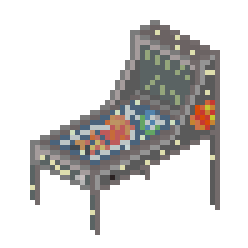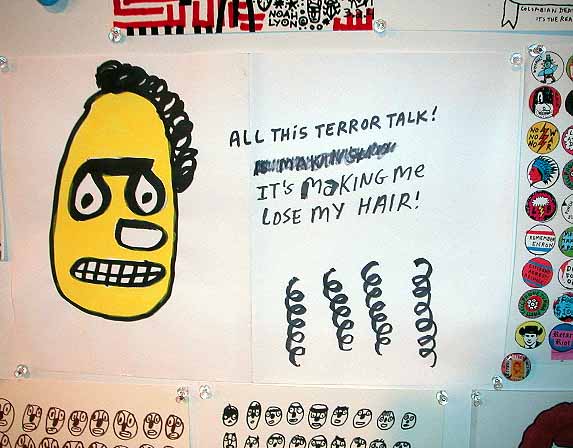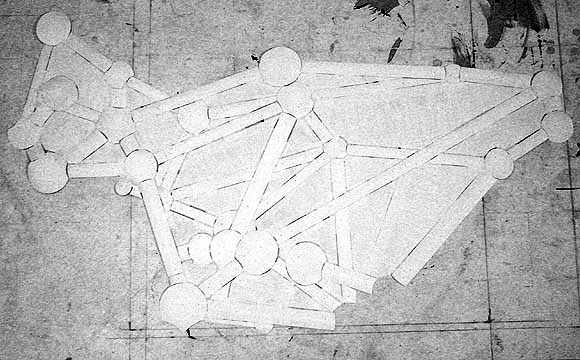View current page
...more recent posts
A recent poll cited in the New York Times says 53% of New Yorkers fear a terrorist attack during the convention. Well, score one for Tom Ridge and the Fear Machine. What I'm most afraid of is that New York police will forget who they're paid to protect and start busting heads of average citizens fed up with three years of Republican kleptocracy, lies about 9/11, and bloody war. Protest is a right, not a privilege as Mayor Bloomberg would have it. The presence of riot gear and heavy handed crowd control tactics during the anti-Iraq war marches of 2003, which I witnessed firsthand, make me concerned that repression will lead to violence, as opposed to the other way around. In the February 2003 march, the police used barricades to keep people confined to the wide avenues and off the cross streets--which was fine unless you wanted to get across town from the West Side to 1st Avenue, where the rally was, which tens of thousands did. Bloomberg's tactic was to make the crowd give up and disperse by creating an impossible, exhausting maze of barricades. I wanted to scream at the cops who wouldn't let us walk on the cross streets--I mean, this was not a gang of criminals or anarchists here, just people who wanted to go to the rally. I found myself imagining a flash mob suddenly appearing and (non-violently) restraining them, through sheer force of numbers, allowing everyone penned in on the Avenue to exercise their constitutional right to walk the shortest distance between two points.

![]() ryan-gfx (skip intro if there is one)
ryan-gfx (skip intro if there is one)

![]()
Death to the Fascist Insect That Preys on the Life of the People
The larger issues percolating around the 2004 Whitney Biennial were (A) whether the "quest for the adolescent" theme identified by the curators was real (as opposed to a thesis in search of evidence), and (B) if real, the extent to which the retreat into infantilism was (i) a response to the current pervasive terror-talk and war, (ii) a reaction to 20 years of verbal theory and no fun in art, or (iii) widespread, simultaneous opting out of participation in an art historical lineage in favor of private (outsider-ish) worlds. The pervasiveness of what Roberta Smith calls "the bedroom shows" and the rise of collectives of 20-something artists documented by Holland Cotter suggests that the trend is real. Militating against that conclusion, however, is anecdotal evidence that the curators were scouting for "young artists" out in the field, and may have skewed the survey in favor of "stuff young artists do." But then previous generations of "young artists" made ultraserious, high-toned work in their 20s, as opposed to wacky, pop-culture-driven room-filling jamborees: think Frank Stella, Gordon Matta-Clark, Eva Hesse, even Cindy Sherman & Robert Longo.
So, if we accept that this is a legitimate sociocultural trend, why the regression into the visual equivalent of baby talk? Perhaps it depends on which preschool we're talking about. The Whitney curators may very well have skimmed the most non-threatening and apolitical work out of the youthpool, while contemporaneous shows in Brooklyn and elsewhere show a "worried generation" mingling concerns about military, labor, environment, and culture-war issues with a faux-unengaged, faux-juvenile stance. Not precisely Dadaists waiting out WWI in Zurich, because overt references to current events are mixed in. I'm intrigued by James Wagner's reporting and pictures from a show I missed in DUMBO (Brooklyn) called "Death to the Fascist Insect That Preys on the Life of the People." The title is from the Symbionese Liberation Army (last invoked in the artworld in the early 90s "nihilistic" scatter art of Cady Noland), but here the grimness of Cinque De Freeze's social indictment is completely belied by the artwork on view: toys, stuffed animals, stickers, buttons, and crude thumbtacked drawings resembling an end-of-the-semester children's art show.
Based on James' photos and descriptions and what I know about some of the artists, the show looked to be an entertaining but tough-minded mix of influences: the Kenny Scharf Jetsons East Village blacklight funhouse thing, Basquiat "drawerly" cartooning, graffiti, the late 80s/early 90s slacker style, and, through manipulation of Saturday Morning sugar cereal advertising tropes, even the hardnosed, political "pictures" art of Levine, Goldstein, Prince, etc. The use of websites to document shows and present stand-alone pieces (by TAG Projects, who did the "Insect" show, but also BEIGE, Paper Rad, etc.) makes this a new animal, though. These are just the beginnings of a theory (and sorry it's so ponderous--just trying to get the thoughts down), but suddenly there's a lot of good work out there, and I'm excited by the role websites and bloggers like James are playing in documenting it, before it reaches the cooled down, institutional phase of magazine coverage and curatorial co-opting.
Noah Lyon, from "Death to the Fascist Insect..." Photo by James Wagner.
The "Infinite Fill Show" is now officially down, and the gallery, Foxy Production, suggested a way to pull up the somewhat obsessive posting on the subject here, which I hadn't thought of (duh): just click http://www.digitalmediatree.com/tommoody/?search=infinite+fill. That brings up 20 posts, including this one. Comments aren't included in the search, so you have to click on those separately. If you click http://www.digitalmediatree.com/tommoody/?search=infinite, you get 7 extra off-topic (but really good!) posts.
By the way, for anyone who wants to cite this page in a bio, press release or angry spam email, "Tom Moody" is preferred, or secondarily, "Tom Moody's Weblog." While "Digital Media Tree" sometimes appears as a cite for this log, that's not really correct; the Tree is a weblog collective and each of us has our own independent, wholly unedited content.
The blogosphere's all a-buzz over Kerry's "tough" ad called Old Tricks. It features a clip from a 2000 debate where John McCain tells Bush he should be "ashamed" for sliming McCain as anti-veteran, through fringe group surrogates. The camera moves to Bush's face, just as it is assuming what Joshua Marshall calls a "callow, trapped look," and freezes in a kind of "gotcha" way. The screen goes dark and the commercial ends with the caption "America Deserves Better." This is so manipulative--I hate that elections get decided on such gimmicky editing tricks. In case anyone else wondered how Bush answered McCain, here's an excerpt from a recent James Fallows article, liberated from the Atlantic's archive via the google cache:
McCain held a tight smile. "Let me tell you what really went over the line," he said shortly afterward, when asked by King for a reply. At a recent Bush rally Bush had stood alongside someone McCain called "a spokesman for a fringe veterans' group," who had denounced McCain for "abandoning" Vietnam veterans.
With feigned politeness, McCain told Bush, "I don't know if you can understand this, George, but that really hurts. It really hurts." No mention of McCain's service as a military pilot, nor of his imprisonment and torture in the "Hanoi Hilton"; everyone knew what McCain meant. McCain turned to King. "And so five United States senators—Vietnam veterans, heroes, some of them really incredible heroes—wrote George a letter and said, 'Apologize.' You should be ashamed."
Bush sputtered, "Let me speak to that ..."
McCain faced him again, calm but contemptuous: "You should be ashamed."
It went on for minutes. Bush protested McCain's underhanded tricks—why, one of McCain's supporters, the former senator Warren Rudman, had said that the Christian Coalition included "bigots." Of McCain's military heroism Bush lamely said, "I'm proud of your record, just like you are," and conceded—in an "okay, are you happy now?" tone—that McCain had "served his country well" and had not abandoned veterans. But he was still unhappy himself: "You can disagree with me on issues, John, but do not question—do not question my trustworthiness, and do not compare me to Bill Clinton." It was Bush's worst onstage moment in the 2000 campaign. He managed to sound both self-righteous and rattled by McCain's direct challenge to his tactics and implied slight to his courage. This is a tape the Kerry campaign will want to examine—while remembering that Bush went on to beat McCain in South Carolina.
What is this, Self-Hating Artists Day? (friendly dig --ed.) We're talking about the James Elkins book What Happened to Art Criticism? Both simpleposie and Sally applied a word used here, "position," to artists in a rather noxious way. Just for the record, it wasn't used on this blog as a verb ("position themselves") or qualified with other words ("pretense to an art historical position"). Not sure where these pejoratives are coming from, attached to us artists: if we don't love and believe in what we do, how can we expect others to?
Elkins uses the word in posing the rather silly question of whether academic and journalist critics should "take a position," as opposed to, one supposes, being forever will-of-the-wisps and gadflys. And I responded that an actual debate that took place between an academic and an artist over an actual position, Minimalism, was more interesting than that question. In the Robert Smithson vs Michael Fried dustup of the late 1960s, Smithson was acting as spokesman for a group of artists who had come under attack (some didn't like having him as a spokesman, but that's another story). The object of the dialogue was not to nail down Minimalism's "place in art history" but first of all, what it was.
If we're talking about a position vis a vis an individual artist as opposed to a movement, a better word is "vision," or less grandiosely, "the artist's thing." The catalog essay or press release is the first articulation of that thing (after the thing itself). In a world where the first spin on your work is likely going to come from a harried journalist looking at dozens of shows, you should probably try to write that statement as well and clearly as possible to head off possible factual errors or misreadings of tone. The last thing you want is someone "interpreting" for you, if that means ignoring your own clearly expressed feelings (e.g, calling your work sad when it's not). Unless you truly don't care about how it's going to be read and discussed in the future.
Once that "first draft" is out there, then it's fair game. If a larger position emerges through comparison (by artists, academics, journos, the public, or whoever) of your work to other works, then so be it--or rather, cool! You certainly have the right to pitch in and argue for your thing during the process.
As for the abstract evalution of critical practice Sally mentions, I think it's interesting in a shop talk kind of way, but less important than discussing actual artworks, good ones of which exist in a substantial unevaluated-to-evaluated ratio.

To sum up an earlier post about James Elkins' book What Happened to Art Criticism? Asking that question is a bit like fussing over the drapes while a rhinoceros crashes about your living room (or whatever metaphor gets this across). Like it or not, artists keep making art; you can either describe it, using whatever tools and venues are available, until a theory becomes clear, or worry about less important "writerly" concerns, like classifying different types of criticism and asking whether they're up to the job.



